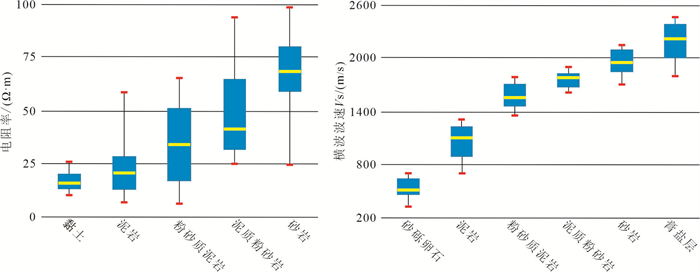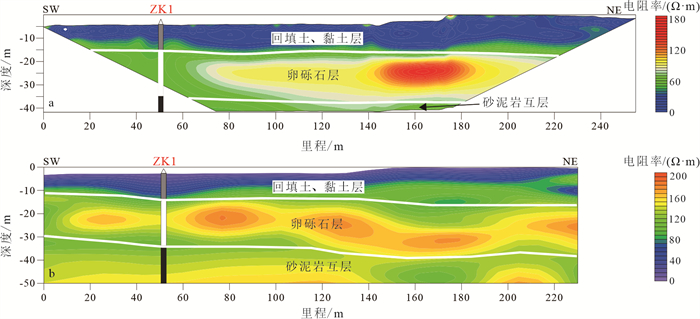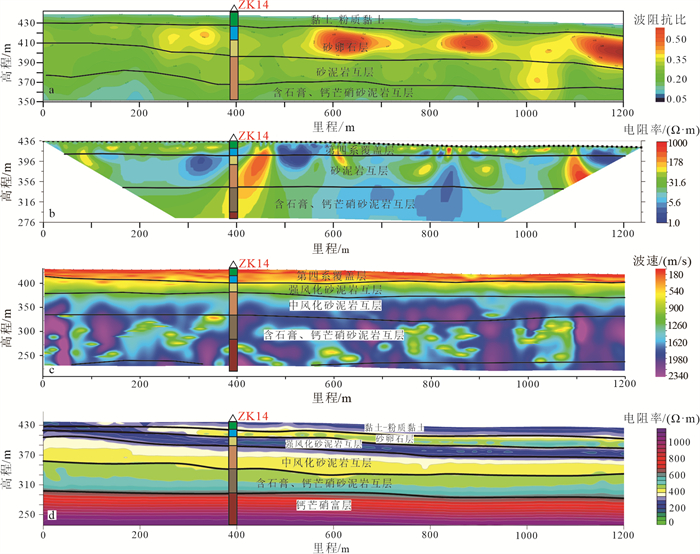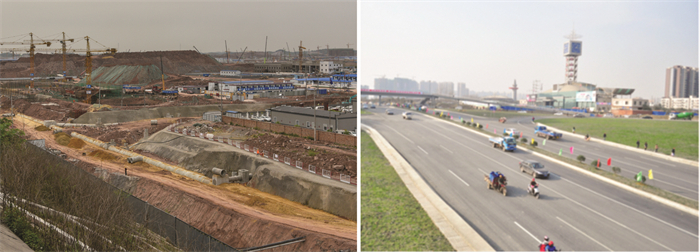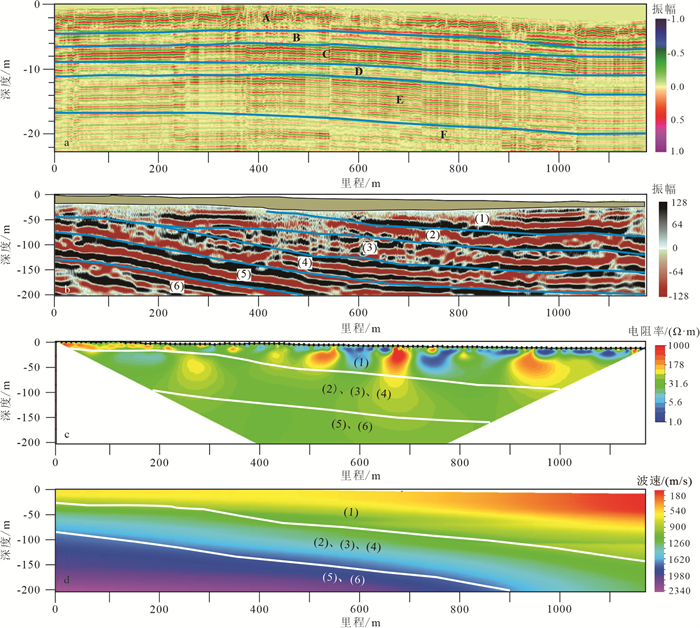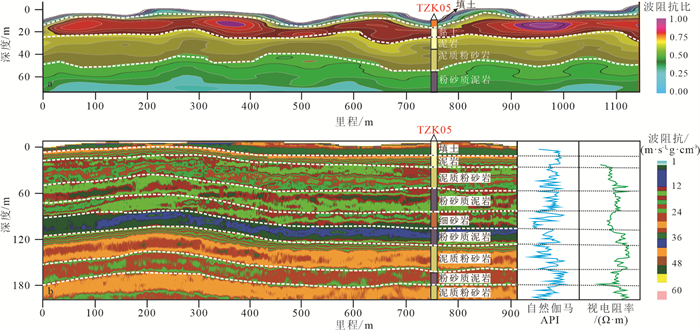The application effect of geophysical method in fine exploration of urban geological structure and study of optimal combination method: A case study of Tianfu New Area in Chengdu, Sichuan Province
-
摘要:
研究目的 成都市天府新区属于典型的西南红层地区,其地层结构呈泥岩、粉砂质泥岩、泥质粉砂岩、砂岩互层结构,不同岩性之间的物性差异相对较小,研究浅部地质结构探测方法,有利于实现城市三维精细地质模型的建立。
研究方法 本文在成都天府新区4个典型试验区,采用多种新的和传统的地球物理方法开展了地质结构精细探测试验。
研究结果 地质雷达、三分量频率共振具有较高的分辨率,其次是浅层地震勘探、高密度电阻率法、等值反磁通瞬变电磁法、微动勘探;地质雷达和等值反磁通瞬变电磁抗干扰能力最强,浅震、三分量共振、微动勘探受城市噪音干扰比较严重;采用地质雷达、三分量频率共振、高密度电阻率法、等值反磁通瞬变电磁法、浅层地震、微动勘探等方法进行组合探测,可以获得由浅至深不同深度范围内的地质结构分层。
结论 通过对比分析每种方法的探测深度、分辨率、抗干扰强度、施工效率和经济成本,形成了适应于成都市天府新区不同工况、不同探测深度的地质结构精细探测地球物理方法最优组合方案。
Abstract:This paper is the result of urban geological survey engineering.
Objective Tianfu New Area (TNA) of Chengdu is characterized by a typical red stratigraphy in southwest China, including interbed sedimentary rocks of mudstone, silty mudstone, argillaceous siltstone and sandstone. The difference of physical property among the above rocks is minor. Clarifying the shallow geological structure by geophysical method is favor for constructing the fine three-dimensional geological model of TNA.
Methods This paper attempts to image fine geological structure in 4 typical sites of TNA through a variety of new and traditional geophysical methods.
Results Ground penetrating radar (GPR) and three component frequency resonance (TCFR) have higher imaging resolution than that of shallow seismic exploration (SSE), electrical resistivity tomography (ERT), opposing coils transient electromagnetic (OCTEM) and microtremor exploration (ME). Urban noise tends to affect field data quality in SSE, TCFR and ME, but not in GPR and OCTEM. Fine geological structure from shallow to deep depth can be obtained by method assembly for GPR, TCFR, ERT, OCTEM, SSE and ME.
Conclusions Under comparing and analyzing the detection depth, resolution, anti-urban noise level, construction efficiency, and economic cost of the above methods, the optimal geophysical method assembly to detect fine geological structure with different construction conditions and exploration depths in TNA of Chengdu is summarized.
-

-
表 1 成都市天府新区主要地层岩性物性参数
Table 1. Physical parameters of different lithology in Tianfu New Area of Chengdu City

表 2 城市地球物理探测技术探测深度和主要优缺点分析统计
Table 2. Statistics of detection depth and main advantages and disadvantages of urban geophysical exploration technology
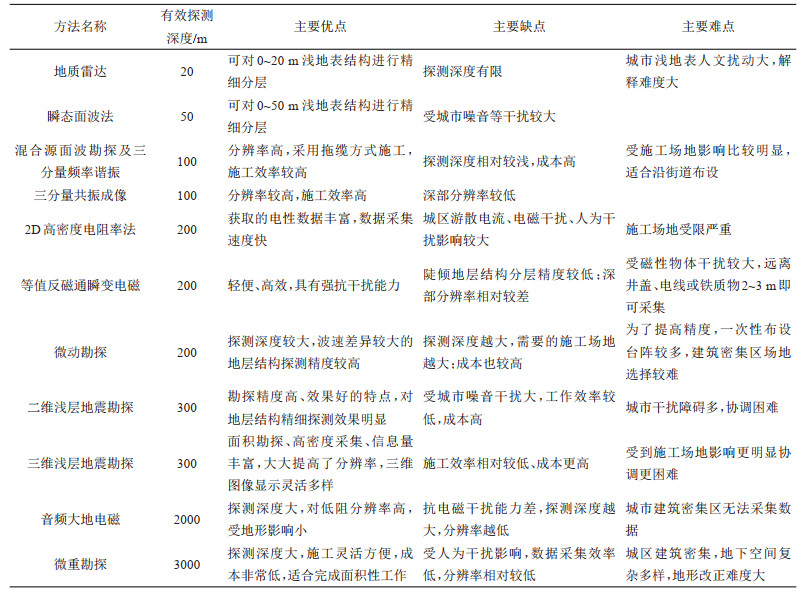
表 3 成都市天府新区地质结构探测方法最优组合方案
Table 3. Optimal combination scheme of geological structure detection methods in Tianfu New Area of Chengdu City

-
Andersen T R, Poulsen S E, Thomsen P, Havas K. 2018. Geological characterization in urban areas based on geophysical mapping: A case study from Horsens, Denmark[J]. Journal of Applied Geophysics, 150: 338-349. doi: 10.1016/j.jappgeo.2017.08.009
Chen Yu, Chen Longsheng, Yu Sheng. 2003. Urban geophysics: A new discipline of earth science[J]. Journal of Geodesy and Geodynamics, 23(4): 1-4 (in Chinese with English abstract).
Chen Qiyu, Liu Gang, Wu Chonglong, Li Xinchuan, Zhang Zhiting. 2016. Knowledge-driven multiple scale 3D geological modeling method in urban geological survey[J]. Geography and Geo-Information Science, 32(4): 11-16 (in Chinese with English abstract).
Deng Qidong, Xu Xiwei, Zhang Xiankang, Wang Guangcai. 2003. Methods and techniques for surveying and prospecting active faults in urban areas[J]. Earth Science Frontiers, 10(1): 93-104 (in Chinese with English abstract).
Fang Yinchen, Gong Rixiang, Li Sanfeng, Pan Shengyong, Gu Mingguang, Huang Weiping. 2017. Suitability evaluation of underground space development based on a three-dimensional geological model: Using the Jiaxing urban geological survey as an example[J]. Shanghai Land & Resources, 38(2): 43-45 (in Chinese with English abstract). doi: 10.3969/j.issn.2095-1329.2017.02.011
Feng Shaoying, Liu Baojin, Zhao Chengbin, He Yinjuan, Tang Yali, Jia Yanxia. 2015. The application experiment of three-dimensional seismic reflection method in the detection of active faults: A case from Luhuatai fault[J]. Seismology and Geology, 37(2): 627-637 (in Chinese with English abstract).
Ge Rubing. 2011. The application of high-density resistivity to detecting urban underground objects[J]. Geophysical and Geochemical Exploration, 35(1): 136-139 (in Chinese with English abstract).
Ge Weiya, Wang Rui, Zhang Qing, Xing Huaixue, Zhou Jie. 2021. Conception of comprehensive utilization evaluation of urban underground space resources[J]. Geological Bulletin of China, 40(10): 1601-1608 (in Chinese with English abstract).
Guo Shili, Duan Jianxian, Zhang Jianfeng, Li Xiuzhong. 2019. Application of GPR in urban road hidden diseases detection[J]. Progress in Geophysics, 34(4): 1609-1613 (in Chinese with English abstract).
Hao Aibing, Lin Liangjun, Li Yamin. 2017. Vigorously promote the multi-factor urban geological survey of accurate service urban planning and construction management of the whole process[J]. Hydrogeology & Engineering Geology, 44(4): 3 (in Chinese).
Huang Lishan, Hou Yijun, Chen Yuanrong, Jing Rongzhong, Wang Jianchao, Zhao Yi, Li Xuebiao, Pei Chao, Zeng Youqiang, Zeng Hui. 2022. Rapid and accurate positioning concealed fault using geophysical and geochemical techniques in cities and surrounding areas——A case study of Lingui District, Guilin City, Guangxi[J]. Geology in China, 49(3): 929-942 (in Chinese with English abstract).
Li Diquan, Di Qingyun, Wang Guangjie, Li Yingxian, Shi Kunfa, Yue Anping, Bai Dawei. 2008. Fault detection by CSAMT and its application to new district planning in Beijing[J]. Progress in Geophysics, 23(6): 1963-1969 (in Chinese with English abstract).
Li Pengyue, Hang Haodong, Wang Donghui, Wang Chunshan. 2021. Current situation and development trends of suitability evaluation of urban underground space resources[J]. Sedimentary Geology and Tethyan Geology, 41(1): 121-128 (in Chinese with English abstract).
Li Qiang, Zhang Ji, Chen Sihong, Pu Wenbin. 2023. Investigation and evaluation of shallow geothermal energy resources in key areas of Chengdu[J]. Sedimentary Geology and Tethyan Geology, 43(2): 271-282 (in Chinese with English abstract).
Li Xuejun. 2011. Applications and development of city geophysical prospecting in China[J]. Progress in Geophysics, 26(6): 2221-2231 (in Chinese with English abstract).
Li Zhixiang, Mao Xianjin, Han Ming, Lü Ming, Long Delong. 2003. An application of high-density resistivity method to surveying blind fault[J]. Journal of Seismological Research, 26(3): 275-278 (in Chinese with English abstract).
Lin Liangjun, Li Yamin, Ge Weiya, Hu Qiuyun, Li Xiaozhao, Li Yun, Meng Hui, Zhang Lizhong, Yang Jianfeng. 2017. General ideas for urban geological survey in China and key theory and techniques[J]. Geology in China, 44(6): 1086-1101 (in Chinese with English abstract).
Liu Baojin, Chai Chizhang, Feng Shaoying, Zhao Chengbin, Yuan Hongke. 2008. Seismic exploration method for buried fault and its upbreak point in Quaternary sediment area: An example of Yinchuan buried active fault[J]. Chinese Journal of Geophysics, 51(5): 1475-1483 (in Chinese with English abstract).
Qiu Enxi, Kang Jingwen, Zheng Lining, Guo Yongchun, He Jianjun. 2015. Study of corrosion characters of red-bed soft rock containing saline deposit in Chengdu[J]. Chinese Journal of Rock and Soil Mechanics, 36(S2): 274-280 (in Chinese with English abstract).
Qiu Kaili, Chu Yongbin, Zhang Zhiming, Li Hu. 2014. Spatial distribution of geological hazards in Tianfu district (Chengdu part)[J]. Journal of Guilin University of Technology, 34(2): 245-253 (in Chinese with English abstract).
Su Maoxin, Qian Qihu, Li Shucai, Xueyiguo, Zhang Qingsong, Yuan Daohong, Nie Lichao. 2011. A method of metro advanced geological prediction under karst geology condiction[J]. Chinese Journal of Rock Mechanics and Engineering, 30(7): 1428-1434 (in Chinese with English abstract).
Wang Zizhong, Xu Mo. 2011. Characteristics of red bed containing saline deposit and engineering geological issues of dam foundation in Sichuan Basin(Ⅰ)[J]. Water Resources and Hydropower Engineering, 42(3): 10-12 (in Chinese with English abstract).
Xi Zhenzhu, Liu Jian, Long Xia, Hou Haitao. 2010. Three-component measurement intransient electromagnetic method[J]. Journal of Central South University (Science and Technology), 41(1): 272-276 (in Chinese with English abstract).
Xi Zhenzhu, Long Xia, Zhou Sheng, Huang Long, Song Gang, Hou Haitao, Wang Liang. 2016. Opposing coils transient electromagnetic method for shallow subsurface detection[J]. Chinese Journal of Geophysics, 59(9): 3428-3435 (in Chinese with English abstract).
Xu Peifen, Shi Wen, Ling Suqun, Guo Huili, Li Zhihua. 2012. Mapping spherically weathered "Boulders" using 2D microtremor profiling method: A case study along subway line 7 in Shenzhen[J]. Chinese Journal of Geophysics, 55(6): 2120-2128 (in Chinese with English abstract).
Xu Peifen, Li Shihao, Du Jianguo, Ling Suqun, Guo Huili, Tian Baoqing. 2013. Estimating Cenozoic thickness in the Beijing plain area using array microtremor data[J]. Acta Petrologica Sinica, 29(5): 1841-1845 (in Chinese with English abstract).
Yang Wencai, Tian Gang, Xia Jianghai, Yang Bo. 2019. The prospect of exploitation and utilization of urban underground space in hilly areas of South China[J]. Geology in China, 46(3): 447-454 (in Chinese with English abstract).
Yang Xiaogang, Wang Rui, Huang Wei. 2019. Status and challenges of underground space development and utilization in China based on comparative analysis of typical Chinese cities[J]. Earth Science Frontiers, 26(3): 69-75 (in Chinese with English abstract).
Zhang Maosheng, Dong Ying, Sun Pingping, Liu Jiang, Wang Huaqi, Feng Li. 2023. Theory and method for urban-rural integration, evaluation and cooperative detection of ground and underground space: Example from the urban geological survey of Guanzhong Plain[J]. Northwestern Geology, 56(3): 153-168 (in Chinese with English abstract).
Zhao Pu, Jiang Jie, Wang Xiurong. 2017. Urban underground space exploration key technologies and development trend[J]. Coal Geology of China, 29(9): 61-66 (in Chinese with English abstract).
Zhao Wenjin. 2003. Urban geology and geophysics[J]. Geological Bulletin of China, 22(8): 558-562 (in Chinese with English abstract).
陈顒, 陈龙生, 于晟. 2003. 城市地球物理学发展展望[J]. 大地测量与地球动力学, 23(4): 1-4. doi: 10.3969/j.issn.1671-5942.2003.04.001
陈麒玉, 刘刚, 吴冲龙, 李新川, 张志庭. 2016. 城市地质调查中知识驱动的多尺度三维地质体模型构建方法[J]. 地理与地理信息科学, 32(4): 11-16.
邓起东, 徐锡伟, 张先康, 王广才. 2003. 城市活动断裂探测的方法和技术[J]. 地学前缘, 10(1): 93-104.
方寅琛, 龚日祥, 李三凤, 潘声勇, 顾明光, 黄卫平. 2017. 基于三维地质模型的地下空间开发适宜性评价——以嘉兴城市地质调查工作为例[J]. 上海国土资源, 38(2): 43-45.
酆少英, 刘保金, 赵成彬, 何银娟, 谭雅丽, 贾艳霞. 2015. 3维反射地震方法在活断层探测中的应用试验——以芦花台断层为例[J]. 地震地质, 37(2): 627-637.
葛如冰. 2011. 高密度电阻率法在城市地下目的物探测中的应用[J]. 物探与化探, 35(1): 136-139.
葛伟亚, 王睿, 张庆, 邢怀学, 周洁. 2021. 城市地下空间资源综合利用评价工作构想[J]. 地质通报, 40(10): 1601-1608.
郭士礼, 段建先, 张建锋, 李修忠. 2019. 探地雷达在城市道路塌陷隐患探测中的应用[J]. 地球物理学进展, 34(4): 1609-1613.
郝爱兵, 林良俊, 李亚民. 2017. 大力推进多要素城市地质调查精准服务城市规划建设运行管理全过程[J]. 水文地质工程地质, 44(4): 3.
黄理善, 侯一俊, 陈远荣, 敬荣中, 王建超, 赵毅, 李学彪, 裴超, 曾友强, 曾晖. 2022. 基于物探-化探技术快速精确定位评价城市及周边隐伏断层——以广西桂林市临桂区为例[J]. 中国地质, 49(3): 929-942.
李帝铨, 底青云, 王光杰, 李英贤, 石昆法, 岳安平, 白大为. 2008. CSAMT探测断层在北京新区规划中的应用[J]. 地球物理学进展, 23(6): 1963-1969.
李鹏岳, 韩浩东, 王东辉, 王春山. 2021. 城市地下空间资源开发利用适宜性评价现状及发展趋势[J]. 沉积与特提斯地质, 41(1): 121-128.
李强, 张继, 陈思宏, 蒲文斌. 2023. 成都市浅层地热能资源调查与评价[J]. 沉积与特提斯地质, 43(2): 271-282.
李学军. 2011. 我国城市物探工作的应用与发展[J]. 地球物理学进展, 26(6): 2221-2231. doi: 10.3969/j.issn.1004-2903.2011.06.042
李志祥, 毛先进, 韩明, 吕明, 龙德龙. 2003. 高密度电阻率法在隐伏断层探测中的应用[J]. 地震研究, 26(3): 275-278.
林良俊, 李亚民, 葛伟亚, 胡秋韵, 李晓昭, 李云, 孟晖, 张礼中, 杨建锋. 2017. 中国城市地质调查总体构想与关键理论技术[J]. 中国地质, 44(6): 1086-1101. http://geochina.cgs.gov.cn/cn/article/doi/10.12029/gc20170604
刘保金, 柴炽章, 酆少英, 赵成斌, 袁洪克. 2008. 第四纪沉积区断层及其上断点探测的地震方法技术——以银川隐伏活动断层为例[J]. 地球物理学报, 51(5): 1475-1483.
邱恩喜, 康景文, 郑立宁, 郭永春, 贺建军. 2015. 成都地区含膏红层软岩溶蚀特性研究[J]. 岩土力学, 36(S2): 274-280.
仇开莉, 褚永彬, 张志明, 李虎. 2014. 天府新区(成都部分)地质灾害空间分布特征[J]. 桂林理工大学学报, 34(2): 245-253. doi: 10.3969/j.issn.1674-9057.2014.02.005
苏茂鑫, 钱七虎, 李术才, 薛翊国, 张庆松, 邱道宏, 聂利超. 2011. 一种岩溶地质条件下的城市地铁超前预报方法[J]. 岩石力学与工程学报, 30(7): 1428-1434.
王子忠, 许模. 2011. 四川盆地含膏盐红层特征及坝基工程地质问题(Ⅰ)[J]. 水利水电技术, 42(3): 10-12.
席振珠, 刘剑, 龙霞, 侯海涛. 2010. 瞬变电磁法三分量测量方法研究[J]. 中南大学学报(自然科学版), 41(1): 272-276.
席振铢, 龙霞, 周胜, 黄龙, 宋刚, 侯海涛, 王亮. 2016. 基于等值反磁通原理的浅层瞬变电磁法[J]. 地球物理学报, 59(9): 3428-3435.
徐佩芬, 侍文, 凌苏群, 郭慧丽, 李志华. 2012. 二维微动剖面探测"孤石": 以深圳地铁7号线为例[J]. 地球物理学报, 55(6): 2120-2128.
徐佩芬, 李世豪, 杜建国, 凌苏群, 郭慧丽, 田宝卿. 2013. 微动探测: 地层分层和隐伏断裂构造探测的新方法[J]. 岩石学报, 29(5): 1841-1845.
杨文采, 田钢, 夏江海, 杨波. 2019. 华南丘陵地区城市地下空间开发利用前景[J]. 中国地质, 46(3): 447-454. http://geochina.cgs.gov.cn/cn/article/doi/10.12029/gc20190301
杨晓刚, 王睿, 黄伟. 2019. 基于国内典型城市对比的地下空间开发利用现状及问题分析[J]. 地学前缘, 26(3): 69-75.
张茂省, 董英, 孙萍萍, 刘江, 王化齐, 冯立. 2023. 城乡融合与地上地下空间协同探测评价的理论与方法——以关中平原城市地质调查评价为例[J]. 西北地质, 56(3): 153-168.
赵镨, 姜杰, 王秀荣. 2017. 城市地下空间探测关键技术及发展趋势[J]. 中国煤炭地质, 29(9): 61-66. doi: 10.3969/j.issn.1674-1803.2017.09.12
赵文津. 2003. 城市地质与地球物理[J]. 地质通报, 22(8): 558-562.
-



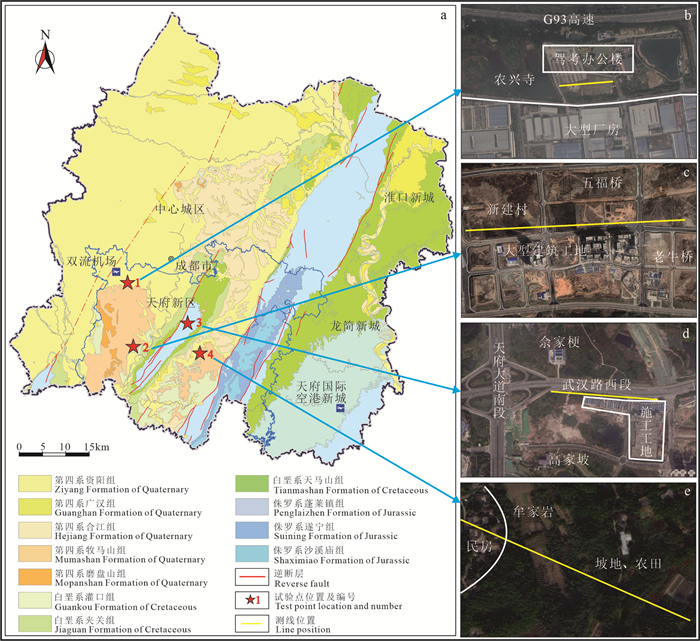
 下载:
下载:
